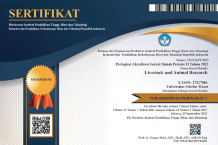Fasciola hepatica in Republic Democratic of Timor-Leste: The prevalence and risk factors associate with it
Abstract
Objective: Fasciola hepatica caused a disease called Fascioliasis. It is a zoonotic disease infects both animals and human. The objective of this research was know the prevalence of F. hepatica in buffaloes in Timor-Leste and to know risk factors associate with the prevalence.
Methods: The method used in this study was multistage random sampling for sites selection and purposive sampling for samples collection. In total there were 486 samples collected from 6 villages from 3 municipalities representing 3 regions (East, central, and west) in Timor-Leste. Samples were collected directly from rectum. The samples were examined using sedimentation method at National Veterinary Laboratory and National Quarantine and Biosecurity laboratory.
Results: The laboratory results indicated that the prevalence of F. hepatica was 17.1% (13.8-20.7%). However, the prevalence of Fasciola hepatica varies according to the municipalities. The Municipality of Manufahi had the highest rate with the prevalence of 25.3% (18.8-32.7), followed by Bobonaro and Baucau with 14.8% (9.7-21.2) and 11.1% (6.7-17.0), respectively. Factors influenced the prevalence F. hepatica identified were: age of the animals, the presence of snails, breeding systems, and body condition scores
Conclusions: According to the study's findings, Fasciola hepatica worms have infected buffaloes in Timor-Leste. It is advised that research on this worm in humans be done as well as animal treatment.
Keywords
Full Text:
PDFReferences
- Garcia-Campos A., C.N. Correia, A. Naranjo-Lucena, L. Garza-Cuartero, G. Farries, J.A. Browne, D.E. MacHugh and G. Mulcahy, "Fasciola hepatica Infection in Cattle: Analyzing Responses of Peripheral Blood Mononuclear Cells (PBMC) Using a Transcriptomi," Frontiers in Immunology, pp. 1-16, 2019.
- Caravedo M.A, and M.M. Cabada, "Human fascioliasis: Current epidemiological status and strategies for diagnosis, treatment, and control.," Research and Reports in Tropical Medicine, vol. 11, pp. 149-158, 2020.
- CDC, "Centers for Disease Control and Prevention (CDC).," Epidemiology & Risk Factors. , 2018. [Online]. Available: https://www.cdc.gov/parasites/fasciola/epi.html. [Accessed 5 June 2023].
- Ayaz S., R.Ullah, N.M. AbdEl-Salam, S.Shams, and S.Niaz, "Fasciola hepatica in some Buffaloes and cattle by PCR and microscopy.," Scientific World Journal. , p. PMID: 25485297 PMCID: PMC4248420, 2014.
- Marques, S. M. T., and M.L. Scroferneker , "Fasciola hepatica infection in cattle and buffaloes in the State of Rio Grande do Sul, Brazil.," Parasitologia Latinoamericana, vol. 58, no. 3-4, pp. 169-172, 2003.
- Rosilawati, K., S. Ramli, and A.R. Bahari, "Fascioliasis in an adult draught buffalo in Malaysia: a case report.," Malaysian Journal of Veterinary Research, vol. 8, no. 1, pp. 169-172, 2017.
- El-Tahawy, A. S., N. Kwan, and K. Sugiura., "Fasciola hepatica infection in water buffalo Bubalus bubalis in three provinces of the Nile Delta, Egypt: A cross-sectional study.," Journal of Veterinary Medical Science., vol. 80, no. 1, pp. 28-35, 2018.
- Dracz, R. M., and W. dos S. Lima, "Autochthonous infection of buffaloes and cattle by Fasciola hepatica in Minas Gerais, Brazil.," Revista Brasileira de Parasitologia Veterinária, vol. 23, no. 3, pp. 413-416, 2014.
- Rizwan M., M.R. Khan, M.S. Afzal, H. Manahil, S.Yasmeen, M.Jabbar, S. Irum, S. Simsek, S. Wasif, T. Mahmood, H. Ahmed, and J. Cao., "Prevalence of Fascioliasis in Livestock and Humans in Pakistan: A Systematic Review and Meta-Analysis.," Tropical Medicine and Infectious Disease, vol. 7, no. 1, p. 126, 2022.
- Development, "QGIS Geographic Information System," Open Source Geospatial Foundation Project, 2022. [Online]. Available: http://qgis.osgeo.org.
- R. Singh, "Determination of age of farm animals.," 2022. [Online]. Available: website: https://www.pashudhanpraharee.com/determination-of-age-of-farm-animals/. [Accessed 16 February 2023].
- Singh, N., H.Kr. Gulati, S. Kumar, S, Dhillod and S. Sahu , "Study of body condition scores and its relationship with various body measurements in Murrah buffalo .," The Pharma Innovation Journal, vol. 8, no. 2, pp. 106-110, Singh, N., H.Kr. Gulati, S. Kumar, S, Dhillod and S. Sahu. (2019). 2019.
- Singh R., S.S. Randhawa and C.S. Randhawa, " Body Condition scoring by visual and digital methods and its correlation with Ultrasonographic back fat thickness in transition buffaloes.," Buffalo Bulletin (Januari-March 2017), vol. 36, no. 1, pp. 169-181, 2017.
- Thrusfield, M., R. Chirstley, H. Brown, P.J. Diggle, N. French, K. Howe, L. Kelly, A. O'Connor, J. Sargeant and H. Wood., Veterinary Epidemiology, Willey-BlackWell. , 2018.
- Taylor M. A., R.L. Coop, and R.L. Wall, Veterinary Parasitology, 4 th Ed., Oxford: Blackwell Publishing, 2016.
- Thrusfield, M and R. Christley (with), Veterinary Epidemiology, Haboken-New Jersey: Wiley-Blackwell, 2018, p. 275.
- M. Szumilas, "Statistical question: Odds ratios," J. Can Acad Child Adolesc Psychiatry, vol. 19, no. 3, pp. 227-229, 2010.
- Kahn, H.A and C. T. Sempos, Statistical Methods in Epidemiology, Oxford: Oxford University Press, 1989.
- OCHA, "Timor-Leste (TLS) Administrative Boundary Common Operational Database (COD-AB),” The United Nations Office for the Coordination of Humanitarian Affairs (OCHA)," 2022. [Online]. Available: https://data.humdata.org/dataset/cod-ps-tls (accessed Jun. 12, 2022). [Accessed 12 June 2022].
- Najib, M. A.,N.J.N. Izani, W.A.W.W.N. Amilah, A.M. Faez, and Z. Shafizol, "A scoping review of the prevalence of fascioliasis in Malaysia and risk factors for infection.," Malaysian Journal of Medical Sciences, vol. 27, no. 1, pp. 22-36, 2020.
- Beesley, N. J., C. Caminade, J. Charlier, R.J. Flynn, J.E. Hodgkinson, A. Martinez-Moreno, M. Martinez-Valladares, J.Perez, L. Rinaldi and D. J. L. Williams, "Fasciola and fasciolosis in ruminants in Europe: Identifying research needs," Transboundary and emerging diseases, vol. 65, no. Suppl 1, pp. 199-216, 2018.
- Jaja, I. F., B. Mushonga, E. Green and V. Muchenje, "Seasonal prevalence, body condition score and risk factors of bovine fasciolosis in South Africa.," Veterinary and Animal Science, 4(June), 1–7., vol. 4, no. June, pp. 1-7, 2017.
- Zhang, J. L., H.F. Si, X.Z. Zhou, X.F. Shang, B. Li, and J.Y. Zhang, "High prevalence of fasciolosis and evaluation of the efficacy of anthelmintics against Fasciola hepatica in buffaloes in Guangxi, China.," International Journal for Parasitology: Parasites and Wildlife, vol. 8 , no. December 2018), pp. 82-87, 2019.
- Takeuchi-Storm, N., M. Denwood, T.V.A. Hansen, T. Halasa, E. Rattenborg, J. Boes, H.L. Enemark, and S.M. Thamsborg, "Farm-level risk factors for Fasciola hepatica infection in Danish dairy cattle as evaluated by two diagnostic methods," Parasites and Vectors, vol. 10, no. 1, pp. 1-11, 2017.
- Maqbool, A., C.S. Hayat, T. Akhtar, and H.A. Hashmi, "Epidemiology of fasciolosis in buffaloes under different managemental conditions.," Veterinarski Arhiv, vol. 72, no. 4, pp. 221-228, 2002.
- Bilal, M. Q., A. Hameed, and T. Ahmad, "Prevalence of gastrointestinal parasites in buffalo and cow calves in rural areas of Toba Tek Singh, Pakistan.," Journal of Animal and Plant Sciences, vol. 19, no. 2, pp. 67-70, 2009.
Refbacks
- There are currently no refbacks.










